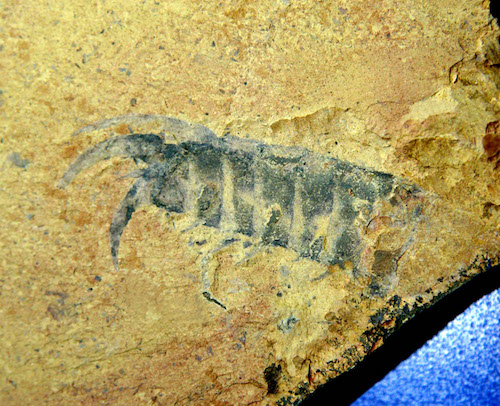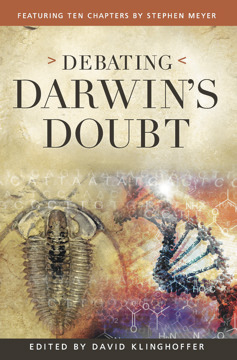 Evolution
Evolution
 Intelligent Design
Intelligent Design
Denying the Signature: Functional Information Is the Fact to Be Explained

Editor’s note: Readers of Evolution News likely know the central thesis of Stephen Meyer’s bestseller, Darwin’s Doubt: The Explosive Origin of Animal Life and the Case for Intelligent Design. Meyer argues that the functional biological information necessary to build the Cambrian animals is best explained by the activity of a designing intelligence, rather than an undirected, materialistic evolutionary process. Most reviews of Darwin’s Doubt curiously omitted to address or even to accurately report this central claim. However, a review by philosophers Robert Bishop and Robert O’Connor in Books & Culture was a welcome exception. In this series, adapted from Debating Darwin’s Doubt, edited by ENV‘s David Klinghoffer, Dr. Meyer responds to their critiques. This is Part 2 of the series. Look here for Part 1.
 Philosophers of science analyzing scientific arguments make a clear distinction between what needs to be explained (the relevant facts in question) and the competing explanations of those facts. They call the former the explanandum and the latter the explanans. Bishop and O’Connor do not offer a competing explanation (another explanans) for the origin of biological information. Instead, they dispute my characterization of what needs to be explained (the explanandum). They do so in several ways, which I will discuss in the next two articles in this series.
Philosophers of science analyzing scientific arguments make a clear distinction between what needs to be explained (the relevant facts in question) and the competing explanations of those facts. They call the former the explanandum and the latter the explanans. Bishop and O’Connor do not offer a competing explanation (another explanans) for the origin of biological information. Instead, they dispute my characterization of what needs to be explained (the explanandum). They do so in several ways, which I will discuss in the next two articles in this series.
First, they question my characterization of DNA and RNA as molecules rich in functional digital information and my characterization of the gene expression system as an “information processing system” — in so doing, presumably raising questions about the need to explain the origin of these features of living systems. Specifically, Bishop and O’Connor assert that “talk of ‘genetic codes’ and ‘information processing’ with respect to the origin of life… can be very limited if not misleading.”
They argue that “abstracted notions of programs and processing seem inadequate to capture the exquisite precision and reliability of these processes.” In order to describe the process of protein synthesis more accurately, they argue that I should abandon an “information processing metaphor.”
Bishop and O’Connor are correct that, if not carefully defined, the term information can be misleading and lead to equivocation. But in both of my books I not only acknowledge this, but take great pains to avoid such confusion. I carefully define the type of information that reliably indicates the activity of an intelligent agent (functional or specified information, also known as specified complexity) and distinguish it from a type of information that does not, namely, Shannon information (or mere complexity) — in the latter case, information that may not perform a function. I also distinguish functional information generally from a special type of functional information (semantic information) in which meaning is conveyed to, and perceived by, conscious agents. (See Signature in the Cell, Chapter 4, and Darwin’s Doubt, Chapter 8, for definitions.)
In so doing, I make clear that DNA contains functional information but definitely not semantic information. Bishop and O’Connor completely ignore this crucial discussion in their review and, consequently, express unfounded worries about the use of the term information as a “metaphor” in biology. Indeed, had I implied that the information in DNA conveyed semantic meaning, my description would have been inaccurate — and, at best, metaphorical. Nevertheless, both books clearly state that DNA contains functional or specified information and argue (based upon our uniform and repeated experience) that such information, as opposed to Shannon information, reliably indicates the activity of a designing intelligence.
As my colleague Casey Luskin has established, no serious biologist post-Watson and Crick has denied that DNA and RNA contain functional information expressed in a digital form — information that directs the construction of functional proteins (and editing of RNA molecules). Thus, contra Bishop and O’Connor, my characterization of DNA and RNA as molecules that store functional or specified information is not even remotely controversial within mainstream biology.
Nor is my judgment controversial that the gene expression system (the system by which proteins are synthesized in accord with the information stored on the DNA molecule) constitutes an information processing system. That is what the network of proteins and RNA molecules involved in the gene-expression system do: They process (that is copy, translate, and express) the information stored within the DNA molecule. The information processing systems present in the cell may well be much more precise than those that human computer engineers have designed, but that does not mean that describing the gene expression system as an information processing system is inaccurate. Describing the gene expression system as an information processing system is not to employ a metaphor. It is to describe what the system does — again, to process (or express) genetic information.
Bishop and O’Connor’s second objection to my characterization of what needs to be explained is that I have “presuppos[ed] an engineering picture of design.” Instead, they think I should have described protein synthesis as a “teleological process.” As they put it:
Given the length of time over which developmental processes stretch, or the length of time over which self-replicating molecule must have formed in a pre-biotic environment, the abstracted notion of programs and processing seem inadequate to capture the exquisite precision and reliability of these processes.
They also argue that describing the process of protein synthesis as an information processing system implies “rigidly deterministic” processes, rather than a teleological process, at work inside the cell. And they regard a teleological description of this process as “more effective and reliable as a picture of how the nucleus’ processes work so well over such extended periods of time in the face of myriad contingencies.” They further insist that “the more basic self-replicating molecular processes sought by origin of life researchers would also be goal-oriented,” which they think is “why so many biologist have continued using teleological vocabulary and explanation in genetics.”
Here Bishop and O’Connor misrepresent my characterization of the information processing systems at work in cells and create a false dichotomy, among other confusions. In fact, I do characterize the information processing system of the cell in teleological language, and I also reflect on the paradox of Darwinian biologists using “incorrigibly teleological language”1 to describe processes they believe arose through an undirected and purposeless process. As I wrote in Signature in the Cell:
Molecular biologists have introduced a new “high-tech” teleology, taking expressions, often self-consciously, from communication theory, electrical engineering, and computer science. The vocabulary of modern molecular and cell biology includes apparently accurate descriptive terms that nevertheless seem laden with a “meta-physics of intention”: “genetic code,” “genetic information,” “transcription,” “translation,” “editing enzymes,” “signal-transduction circuitry,” “feedback loop,” and “information-processing system.” As Richard Dawkins notes, “Apart from differences in jargon, the pages of a molecular-biology journal might be interchanged with those of a computer-engineering journal.” …[Thus] the historian of biology Timothy Lenoir observes, “Teleological thinking has been steadfastly resisted by modern biology. And yet in nearly every area of research, biologists are hard pressed to find language that does not impute purposiveness to living forms.”2
As the above quotation implies, an engineering picture of life is a teleological picture because engineers who design complex systems, including complex information processing systems, do so purposively. By pitting engineering design and teleology against each other, Bishop and O’Connor create a false dichotomy. They do the same by treating determinism and teleology as opposites. When an engineer imposes constraints on a physical system to achieve a particular functional outcome, he has an end in mind — thus, he is creating a teleological process. But the end he hopes to achieve will only occur if he can count on the reliability of the laws of nature — i.e., deterministic processes. All designed objects take advantage of determinist laws in order to achieve specific outcomes starting from specific sets of constrained (by the engineer) initial conditions. Teleology and determinism are not necessarily opposites because purposive agents can harness deterministic processes to achieve their desired ends. On this point, Bishop and O’Connor simply seem confused.
They make a third argument in this vein, which I will address at length in the next installment.
References:
(1) Signature in the Cell, 22.
(2) Signature in the Cell, 21-22.
